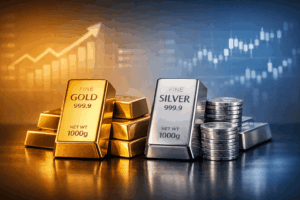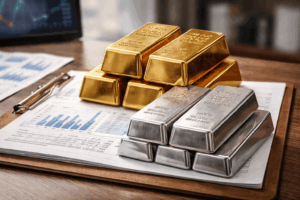Daily News Nuggets | Today’s top stories for gold and silver investors
September 15th, 2025
Fed Set to Cut Rates — How Far Will They Go?
The Federal Reserve is widely expected to cut rates for the first time this year when it meets Tuesday and Wednesday. Markets are pricing in a near-certain 25-basis-point reduction from the current 4.75-5% range.
The real debate: how far will they go? Wall Street calls this the “worst kind of setup” for policymakers balancing persistent inflation against economic cooling. Lower rates typically boost gold and silver by weakening the dollar and reducing the opportunity cost of holding precious metals. If Powell signals more cuts ahead, it could extend the rally that’s already driven gold to record highs.
While gold is consolidating, silver is suddenly stealing the spotlight with its most dramatic move in over a decade…
Silver Breaks $42, Highest Since 2011
Silver surged past $42 an ounce Monday, its strongest level since 2011. The metal’s rise stands out as gold consolidates after recent record highs. A mix of industrial demand and monetary appeal has fueled silver’s climb.
Earlier this year, the gold-to-silver ratio spiked above 100-to-1 — an extreme level we flagged as unsustainable and a potential buying opportunity. Since then, silver has rallied hard, bringing the ratio down to about 85-to-1. That’s still elevated by historical standards (the long-term average is closer to 60-to-1), suggesting silver has more room to run as it continues catching up to gold’s historic move.
But while metals are rallying, inflation remains a stubborn headwind — and some U.S. cities are feeling it far worse than others…
Inflation’s Hot Zones: Tampa, San Diego, Philly Top List
A new WalletHub study reveals which U.S. cities are struggling most with persistent price pressures. Tampa Bay claimed the unwanted crown with a 3.3% annual inflation rate combined with a concerning 1.1% monthly acceleration. San Diego-Carlsbad ranked second, followed by the Philadelphia metro area, where housing and insurance costs are driving the pain.
These regional hotspots show why the Fed’s job remains complicated — inflation is cooling nationally but remains stubbornly high in major metros. This uneven picture could influence how aggressively the central bank cuts rates in coming months, potentially limiting the tailwind for precious metals.
While U.S. cities battle rising costs, Asia’s gold hubs are facing challenges of a different kind…
Bangkok Floats Gold Tax That Could Shake Asian Markets
Thailand is considering a new tax on physical gold trades settled in baht, potentially reshaping one of Asia’s most vibrant gold markets. Finance Ministry and Bank of Thailand officials are actively discussing the levy, which would specifically target local currency conversions while exempting dollar transactions, futures trades, and traditional gold shop purchases.
With $8 billion in annual gold trading activity at stake, the move aims to discourage exporters from converting dollar proceeds into baht — a practice partly blamed for the currency’s 7% surge this year to its strongest level since 2021. Thailand’s gold market serves as a crucial hub for Southeast Asian trading, so any disruption could ripple through regional precious metals flows and potentially redirect demand to other markets.
While Thailand debates restrictions, China is heading in the opposite direction — looking to open up its gold market to the world…
China Proposes Rule Changes to Ease Gold Imports and Exports
China is preparing to loosen its grip on gold trading, proposing new rules that would make it easier for banks and companies to import and export the precious metal. The People’s Bank of China released draft regulations Friday that would streamline licensing procedures and reduce bureaucratic hurdles that have long frustrated international traders.
The timing is significant: China is already the world’s largest gold consumer and producer, yet its strict controls have kept its massive market relatively isolated from global flows. The proposed changes would allow more financial institutions to participate in gold trading and could boost China’s influence over international pricing. With retail investors already piling into gold this year amid property market concerns and currency weakness, easier import rules could unleash even more demand.






